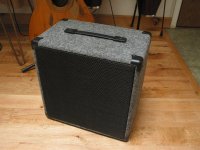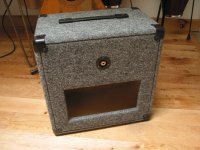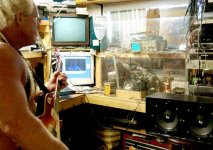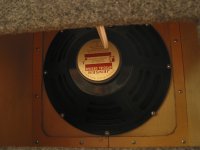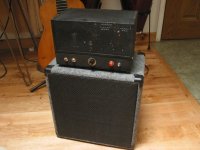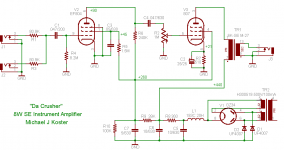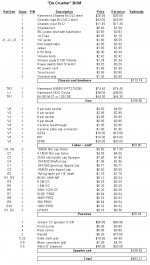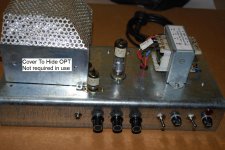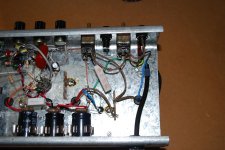If the back opening of the cabinet is large enough vs it's internal volume to place the Helmholz resonance well below the lowest notes, then the enclosure should act like an open baffle and would be analyzed as such. There can be a lot of coloration depending on the 1/2 wave distance around the edge of the baffle. I would expect that and the driver characteristics to define the basic "sound" of the cabinet.
Actually I meant to say when the opening large enough to minimize the Helmholtz effect the enclosure acts as an open baffle.
Hmm. The speaker cab response is not likely to be flat... Where it peaks and dips will create a sound that may or may not work with the instrument, player, and music being played. Sort of like a hollow body guitar. Clearly one doesn't want "wolf tones" or serious muffling of anything, but to some extent it just defines a unique sound, not good or bad.
One thing I have found is I can't predict what I will like from the response plot.
Larger hole = higher tuning
Hmm. The speaker cab response is not likely to be flat... Where it peaks and dips will create a sound that may or may not work with the instrument, player, and music being played. Sort of like a hollow body guitar. Clearly one doesn't want "wolf tones" or serious muffling of anything, but to some extent it just defines a unique sound, not good or bad.
One thing I have found is I can't predict what I will like from the response plot.
I feel, some preferences existed. Something should be hidden in cabinet sizes, in material thickness preferences...
Like, I don't believe that Stradivari used to make instruments of random sizes and proportions.
Larger hole = higher tuning
My little 12 cabinet tunes below 200 Hz, but the effect is not huge for an opening this size.
The 1/2 wave baffle step is above 200 Hz...
This seems to work well with a stiff cone speaker like the C12R I have in there.
Attachments
Last edited:
I don't believe that Stradivari used to make instruments of random sizes and proportions.
Of course not. But how did he find the perfect recipie? Trial and error?
For some people who are skilled in the art, have experience, and know what they want, a simple computer model can spit out a speaker box. For most of us, it's guess, try, repeat.
For amp designs, I proceed the same way. It's that 40+ years of experience minimizes the number of incorrect guesses. For this challenge there was one already. Amp 2.0 is being soldered together right now. There are 2 flavors. One looks "normal" and one has the Tubelab mark of excess on it. I'll post pictures once a few parts are mounted.
Of course not. But how did he find the perfect recipie? Trial and error?
Do you mean everyone who reads this discussion have to rush to saw wood and search for a Holy Grail?
No one dares to share own experience with the community?
of course
My little 12 cabinet tunes below 200 Hz, but the effect is not huge for an opening this size.
The 1/2 wave baffle step is above 200 Hz...
This seems to work well with a stiff cone speaker like the C12R I have in there.
Nice work, very nice!
Do you mean everyone who reads this discussion have to rush to saw wood and search for a Holy Grail?........No one dares to share own experience with the community?
Just as a fiddle player in a bluegrass band wouldn't use a Stradivarius, my cabinets may be of no use to others, and as yet I have no sound samples, but I can share my designs. So far I have one complete guitar cabinet I made over 10 years ago. It can be seen in the lower right of the photo.
The speakers are Electro-Voice 10 inch guitar speakers which were obtained for $69 each at the grand opening sale of the now defunct Mars Music. I don't think they are made any more. These speakers can eat lotsawatts and were designed for a sealed box. I slapped this box together from 1/2 inch MDF. The inside dimensions are 24 inches by 12 inches by 8 inches deep. It likes big power and is seen here eating everything that my Uber Champ test amp running an 833A in SE on 1500 volts could dish out. Over 200 watts. Note the glowing 833A just above the left side of the speaker behind the blast shield. This cabinet sounds best doing a Jimi imitation at ear bleeding volume levels, so may not work for this challenge but I will try it.
I have another cabinet I made in wood shop class, but I still haven't put a speaker in it yet since I have no working amp yet. I went to Home Depot and bought a stack of pine and collected about 10 assorted budget speakers from 6 to 12 inches......stay tuned.
Attachments
George, I am waiting for your Youtube presentations! Good luck!
An externally hosted image should be here but it was not working when we last tested it.
I am waiting for your Youtube presentations!
I need to make something that works first. Then maybe find a real guitar player for a demo. My left hand has become rather stiff and arthritic, goes numb a lot. Don't play guitar anymore.
5 years ago I could find a dozen good players at work. Most were laid off, and half of the building is now off limits. The metal shreader next door moved away and so did my daughters band mates. That is why I haven't done guitar amps in a long time.
Nice cab, but how do you hold the front panel in?
Blind screws extending through the front panel before covering?
Yes.
The idea is tee-nuts inserted into counter-bored recesses before mounting the grille cloth. The speaker mounting screws thread into these as do the front panel mounting screws. The prototype here just uses sheet metal screws...
Attachments
Some owners replace the front baffles of newer amps because they were made from MDF and they feel the sound is too dead. Fender used to have their front baffle of their Tweed amps suspended by four screws, the baffle would continue to vibrate after the note started to decay.
On the topic of vibration and resonances, some acoustic feedback made its way back to the tubes in a combo. Depending on the tube there might be a fine line between enough or too much though.
To my knowledge, these days most factory made cabinets use MDF, chipboard or plywood to keep costs down. Replacing the baffle may improve the sound enough to please given individuals. I see nothing wrong in doing so.
As I said initially, in my experience, if the cabinet is made of cedar or pine then what material was used for the baffle or face will make little difference. Of course if the size of the cabinet and the speaker/s are a mismatch then you will have problems no matter what you use!
We did not talk about it, but woodworking techniques used for building the cabinet will also contribute substantially to the sound. Proper joints and the type of glue used will make a big difference. On the other hand, using screws and/or a loose baffle will degrade the sound!
To my knowledge, these days most factory made cabinets use MDF, chipboard or plywood to keep costs down. Replacing the baffle may improve the sound enough to please given individuals. I see nothing wrong in doing so.
As I said initially, in my experience, if the cabinet is made of cedar or pine then what material was used for the baffle or face will make little difference. Of course if the size of the cabinet and the speaker/s are a mismatch then you will have problems no matter what you use!
We did not talk about it, but woodworking techniques used for building the cabinet will also contribute substantially to the sound. Proper joints and the type of glue used will make a big difference. On the other hand, using screws and/or a loose baffle will degrade the sound!
The baffle board is used as a soundboard as much as the sides. How would pine or some other resonant wood not be better than MDF? As far as the loose baffle degrading the sound, that is not necessarily so.
depends on the construction of the cab, but they can influence the sound quite a bit.
If they're hung from the top and bottom and allowed to float free on the sides, then a thinner baffle (say 3/8" in imperial measurements, if I remember correctly) will resonate quite a bit. You have to make sure that the wood is strong and thick enough to hold the speakers without cracking though, so there's a balance to be struck.
OffsetGuitars.com • View topic - Thickness of "floating baffle boards" Fender style???
Both cabs utilize a classic floating baffle design.
Dr. Z Amplification | 2 x 10 Cabinet
Valvetrain Amps
8" Weber Signature Series speaker, 5 watts out of 1 6v6 tube, preamp is 1 12AX7 tube. Tone knob, volume knob, solid pine cabinet with floating baffle.
A quick primer on cabinets by Gibson
http://www.gibson.com/en-us/Lifestyle/Features/Tone Tips_ Speaker Cabinets/
The baffle board is used as a soundboard as much as the sides. How would pine or some other resonant wood not be better than MDF? As far as the loose baffle degrading the sound, that is not necessarily so.
The baffle made out of pine or any resonant wood will be better than the man made materials. I have never said otherwise! However, in my experience it will not make a big difference. In my opinion this is especially true when the cabinet and the baffle are joint using screws rather than being glued together. If and when the cabinet and baffle are large compared to the size of the speaker it will also make more of a difference what materials and construction techniques were used. The speaker you use will be much more of a difference than the type of baffle material!!!
I appreciate you have a different point of view from mine!
If and when the baffle is a floating one, the baffle should be made of resonant wood and the materials used for the cabinet will make less of a difference. Again this is just my opinion. I personally do not like floating baffle for speaker boxes. I have built them, tried them and they are not for me.
Last edited:
I don't win - a little over budget
Here's my low cost DIY amp. It did go a little over the $100 budget at $469.66 but I priced in use a lot of parts I already had. It includes a 12" cabinet. I may have spent about $100 in additional parts. The parts are all off the shelf available in small quantities to DIY builders, e.g. uses a Hammond chassis, cover, and cage.
I'm still tweaking the voicing, however it's pretty usable as is. The cabinet is made from 2 layers of 1/2" Russian birch laminated together. The baffle is one thickness but is hardly more than a mounting ring.
The circuit is like the Fender Champ but adapted for the 807. It has a mostly clean tone with a nice smooth crunch coming on when digging in. The distortion comes mostly from the first stage as it's somewhat independent of the volume setting.
Here's my low cost DIY amp. It did go a little over the $100 budget at $469.66 but I priced in use a lot of parts I already had. It includes a 12" cabinet. I may have spent about $100 in additional parts. The parts are all off the shelf available in small quantities to DIY builders, e.g. uses a Hammond chassis, cover, and cage.
I'm still tweaking the voicing, however it's pretty usable as is. The cabinet is made from 2 layers of 1/2" Russian birch laminated together. The baffle is one thickness but is hardly more than a mounting ring.
The circuit is like the Fender Champ but adapted for the 807. It has a mostly clean tone with a nice smooth crunch coming on when digging in. The distortion comes mostly from the first stage as it's somewhat independent of the volume setting.
Attachments
Not my cup of tea either, mind you I have heard some Dr Z amps that sound great.The baffle made out of pine or any resonant wood will be better than the man made materials. I have never said otherwise! However, in my experience it will not make a big difference. In my opinion this is especially true when the cabinet and the baffle are joint using screws rather than being glued together. If and when the cabinet and baffle are large compared to the size of the speaker it will also make more of a difference what materials and construction techniques were used. The speaker you use will be much more of a difference than the type of baffle material!!!
I appreciate you have a different point of view from mine!
If and when the baffle is a floating one, the baffle should be made of resonant wood and the materials used for the cabinet will make less of a difference. Again this is just my opinion. I personally do not like floating baffle for speaker boxes. I have built them, tried them and they are not for me.
Gday Guy's,
I've been protyping my 5W amp & tested it just now, still some things to tidy up for the final thing but it comes in at just under $100, $99.65 to be exact.
As you'll see it's not finished but it's close, i'll upload the first sound clip somewhere & post the link.
I called it "The Iron Maiden", its got some balls about it--big sound!
Maybe the Moderator could change something so we can upload MP'3 or something for sound clips--hint hint!
Pictures attached!
Cheers
I've been protyping my 5W amp & tested it just now, still some things to tidy up for the final thing but it comes in at just under $100, $99.65 to be exact.
As you'll see it's not finished but it's close, i'll upload the first sound clip somewhere & post the link.
I called it "The Iron Maiden", its got some balls about it--big sound!
Maybe the Moderator could change something so we can upload MP'3 or something for sound clips--hint hint!
Pictures attached!
Cheers
Attachments
Sorry for the double post, I just uploaded a sound clip on youtube for the 1st test of the Iron Maiden amp.
It's a bit boring & repetative with me just adjusting the tone controls but here goes, any comments good bad or ugly are welcome.
The amp sounds a little bit brighter in real life, I guess recording into the computer WITHOUT EDITING has some effect.
It's a raw recording.
I forgot to mention, as far as guitar amps go, I think you will find it an original design of mine.
Here's the link:
The Iron Maiden - YouTube
Cheers
It's a bit boring & repetative with me just adjusting the tone controls but here goes, any comments good bad or ugly are welcome.
The amp sounds a little bit brighter in real life, I guess recording into the computer WITHOUT EDITING has some effect.
It's a raw recording.
I forgot to mention, as far as guitar amps go, I think you will find it an original design of mine.
Here's the link:
The Iron Maiden - YouTube
Cheers
Last edited:
- Home
- Live Sound
- Instruments and Amps
- The Hundred-Buck Amp Challenge
